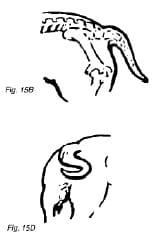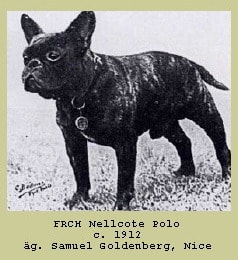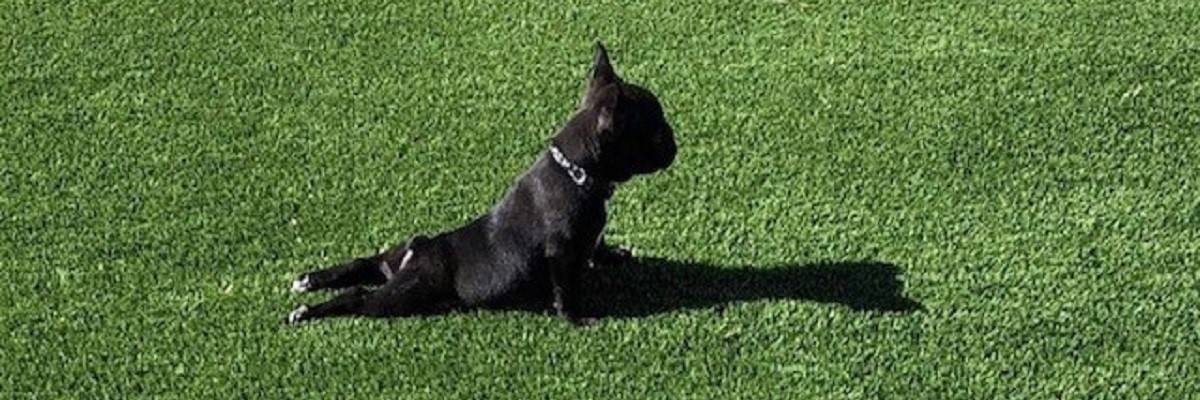The French Bulldog is known for its unique appearance, and its tail is no exception. French Bulldogs have a short, smooth, and relatively straight tail that is typically carried low. The tail is thick at the base and tapers to a point at the end. In some cases, French Bulldogs may have a naturally short or docked tail due to genetics or breeder intervention.
The texture of a French Bulldog’s tail is smooth and glossy, with a fine coat that matches the rest of its body. The tail can come in a variety of colors and patterns, including brindle, fawn, and pied.
Compared to other dog breeds, French Bulldogs have a relatively short tails. This is partly due to the breed’s history as a companion animal rather than a working dog. Short tails were less likely to get caught in machinery or other hazards, making them a safer choice for a lap dog. However, it’s worth noting that not all French Bulldogs have short tails, and some may have longer tails due to genetics or breeding.
| Are their tails docked? | No |
| Are they born with short tails? | Yes |
| Are all the tails the same size? | No |
| Are there issues with a short tail? | Yes |
The American Kennel Club breed guidelines for French Bulldogs state: That they can either have a straight tail or a corkscrew shape across their buttocks. It should be set low and short, lying flat on the rear.

A French Bulldog tail that is too long is deemed a defect, while having no tail at all is also not suited to the existing breed standard. Its tails must not be too high or unnaturally short because they are already deemed defects throughout the breed.
The functionality of the French Bulldog Tail
The French Bulldog’s tail serves several important functions: communication, balance, and expression.
One of the primary roles of the French Bulldog’s tail is communication. Dogs use their tails to express their emotions and communicate with other dogs and humans. A wagging tail, for example, is often a sign of happiness and excitement, while a tucked tail can indicate fear or anxiety. French Bulldogs use their tails to convey their feelings and intentions, and they are known for their expressive tails that often wag in a circular motion.
In addition to communication, the French Bulldog’s tail also helps with balance. The tail acts as a counterbalance when the dog is in motion, helping them to make quick turns and changes in direction. This is especially important for French Bulldogs, as they have a stocky build and can be prone to obesity, which can affect their balance and mobility.
Finally, the French Bulldog’s tail adds to their overall expression and personality. While the tail is relatively short and straight, it is still an important part of the dog’s appearance and helps to distinguish the breed from others. The tail’s shape and movement and the dog’s other physical features, such as their large ears and wrinkled face, give French Bulldogs a distinct and lovable look.
French Bulldogs are able to perform all of the necessary functions with their short tails. While their tails may not be as long as other breeds, they can still communicate through tail movement, maintain their balance, and express themselves uniquely.
French Bulldogs have adapted to having a shorter tail over time, and it does not hinder their overall health or well-being. In fact, the short tail can be an advantage in some situations, such as when the dog is in a small or confined space where a longer tail could get in the way or be at risk of injury.
It’s worth noting that not all French Bulldogs have short tails. Some may have longer tails due to genetics or breeding. However, the short tail is a defining characteristic of the breed and has become a beloved feature among French Bulldog enthusiasts.
So is the tail docked?
The good news is that the French Bulldog’s tail is not docked or removed.
Tail docking is a controversial practice that involves removing a dog’s tail when they are still a puppy. The procedure is typically done for cosmetic reasons or to prevent injury, but it can cause pain and other negative side effects for the dog. The French Bulldog is a breed with a naturally short tail, meaning that tail docking is unnecessary.
Fortunately, the French Bulldog’s tail does not require docking or removal. This is good news for both the dog and its owners, as it means that the dog can maintain its natural appearance and avoid unnecessary pain or trauma.
Tail docking has been a common practice throughout history, with the first documented case occurring in ancient Rome. However, in recent years, many regions of the world have banned or prohibited tail docking due to concerns about animal welfare. Despite this, tail docking is still prevalent in some regions, including the United States and Canada.
In contrast, the French Bulldog’s naturally short tail has been an advantage for the breed throughout its history. The short tail was originally bred for practical reasons, such as avoiding injury and getting caught in machinery. Still, it has also become a defining characteristic of the breed and is beloved by French Bulldog enthusiasts.
Overall, the fact that the French Bulldog’s tail does not require docking or removal is a positive aspect of the breed and a testament to its unique and practical characteristics.
What does tail docking do to the dog?
There are several arguments against tail docking in French Bulldogs and in dogs in general. One of the primary concerns is that tail docking can cause pain and distress for the dog. The procedure involves cutting off part of the tail, which can lead to pain, bleeding, and infection. This can be especially dangerous in young puppies, who are more vulnerable to complications from surgery.
Another argument against tail docking is that it can negatively impact the dog’s communication and expression. Dogs use their tails to communicate their emotions and intentions, and removing part of the tail can make it more difficult for them to express themselves. This is particularly important for French Bulldogs, who are known for their expressive tails and personalities.
In addition to the physical and emotional harm that tail docking can cause, there is also a growing concern about the ethics of the procedure. Many animal welfare advocates argue that tail docking is unnecessary and cruel and that it is done primarily for cosmetic reasons rather than for the dog’s health or well-being.
Legal regulations on tail docking
The practice of tail docking has become increasingly controversial in recent years, and many countries have implemented legal regulations regarding the procedure. In some countries, tail docking is completely banned or prohibited; in others, it is only allowed under certain circumstances.
In the United Kingdom, for example, tail docking is illegal under the Animal Welfare Act of 2006, except in cases where it is necessary for the dog’s health or well-being. In Australia, tail docking is also prohibited in most cases, except for working dogs such as sheepdogs and cattle dogs.
In Europe, tail docking is generally prohibited under the European Convention for the Protection of Pet Animals. This convention prohibits the mutilation of pets, including removing tails or other body parts. Some countries, such as France, allow tail docking for certain breeds if it is done before the puppy is eight days old and is performed by a licensed veterinarian.
In the United States, tail docking is not illegal, but some states have implemented regulations or restrictions on the practice. In California, for example, tail docking is illegal unless it is necessary for the dog’s health or safety, and in New York, tail docking is only allowed for certain breeds if it is done before the puppy is five days old.
Overall, the legal regulations regarding tail docking vary widely from country to country and even from state to state. However, there is a growing trend toward banning or restricting the procedure, with many animal welfare advocates arguing that it is unnecessary and cruel. As more countries and states implement regulations regarding tail docking, it is likely that the practice will continue to decline in popularity and become less common in the future.
The long Tail French Bulldog
While French Bulldogs are typically known for their short, stumpy tails, some French Bulldogs are born with longer tails than usual. These dogs are often referred to as “long tail French Bulldogs,” and they have become increasingly popular among Frenchie enthusiasts in recent years.
Long-tail French Bulldogs are not a separate breed or variety of French Bulldogs; they are simply Frenchies that have longer tails than what is considered standard for the breed. The length of the tail can vary, but it is typically longer than the short, curly tails that are commonly associated with Frenchies.
One of the main advantages of long tail French Bulldogs is that they are often more expressive and communicative than their short-tailed counterparts. With a longer tail, these dogs are better able to communicate their emotions and intentions, which can be especially important for Frenchies, who are known for their playful and affectionate personalities.
However, it is worth noting that long-tail French Bulldogs are still relatively rare, and they may be harder to find than other types of Frenchies. In addition, because they are not considered standard for the breed, they may not be eligible to compete in certain dog shows or competitions.
Overall, long tail French Bulldogs are a fascinating variation of this beloved breed, and they offer unique benefits and advantages that are worth considering for Frenchie enthusiasts. Whether you prefer short-tailed or long-tailed French Bulldogs, there is no denying that these dogs are truly special and beloved by many worldwide.


Little French Dog is a participant in the Amazon Services LLC Associates Program, an affiliate advertising program designed to provide a means for sites to earn advertising fees by advertising and linking to Amazon.com.
Common Tail-Related Health Issues in French Bulldogs
While French Bulldogs are generally healthy and robust dogs, they are prone to a few health issues related to their tails. Here are some common tail-related health issues in French Bulldogs:
- Hemivertebrae: Hemivertebrae is a spinal deformity that can cause the tail to become twisted or kinked. This condition is relatively common in French Bulldogs and can lead to chronic pain and discomfort.
- Tail Infections: French Bulldogs have tight, wrinkle-prone skin around their tails, which can create the perfect environment for bacteria to thrive. As a result, Frenchies are prone to tail infections, which can cause swelling, redness, and discomfort.
- Tail Tip Injuries: Because French Bulldogs have short tails, their tail tips are often close to their bodies, making them more susceptible to injuries. Tail tip injuries can cause the dog pain, bleeding, and discomfort.
- Tail Pocket Infections: Some French Bulldogs have deep tail pockets, which can trap bacteria and cause infections. These infections can be painful for the dog and may require medical treatment.
- Spinal Cord Injuries: French Bulldogs have short tails and a compressed spinal cord, which can make them more susceptible to spinal cord injuries. These injuries can be painful and cause paralysis or other serious health issues.
Tail injuries due to docking or mishandling
Tail injuries in French Bulldogs can also occur due to tail docking or mishandling. As mentioned earlier, tail docking involves the removal of a puppy’s tail, which can cause significant pain and discomfort for the dog. In addition, docking can lead to long-term health issues, such as chronic pain, infection, and nerve damage.
Mishandling can also cause tail injuries in French Bulldogs. For example, if a dog’s tail is accidentally caught in a door or stepped on, it can lead to pain, swelling, and even broken bones. French Bulldogs are especially susceptible to tail injuries due to their short tails and the fact that their tails are often close to their bodies.
If you suspect that your French Bulldog has a tail injury, it is important to seek veterinary care immediately. In some cases, tail injuries can be serious and require medical attention, such as pain management, antibiotics, or even surgery.
To prevent tail injuries in French Bulldogs, handling them gently and avoiding any rough play that could lead to tail injuries is important. Additionally, suppose you are considering adopting a French Bulldog. In that case, it is important to choose a reputable breeder who does not practice tail docking and prioritizes the health and well-being of their dogs.
Overall, tail injuries in French Bulldogs can be painful and serious, but they can be prevented and treated effectively with proper care and attention. By prioritizing your Frenchie’s health and well-being, you can help ensure they live a happy, healthy life free from tail-related health issues.
Tail pocket infections and treatment
Tail pocket infections are a common health issue in French Bulldogs, especially those with deep tail pockets. A tail pocket is a fold of skin around the base of the tail that can trap dirt, debris, and moisture, creating the perfect environment for bacteria to grow.
Symptoms of a tail pocket infection can include redness, swelling, discharge, and a foul odor. If left untreated, the infection can spread to other parts of the dog’s body and cause significant pain and discomfort.
The first step in treating a tail pocket infection is thoroughly cleaning the affected area. This can be done with gentle, antibacterial soap and warm water. Drying the area completely after cleaning is important to prevent further moisture buildup.
In some cases, topical or oral antibiotics may be necessary to treat the infection. Your veterinarian may also recommend a medicated shampoo or cream to help soothe the area and promote healing.
Preventing tail pocket infections in French Bulldogs involves regular grooming and hygiene practices. This includes cleaning the tail area regularly and keeping it dry, especially after swimming or bathing. Additionally, trimming the hair around the tail area can help prevent dirt and debris from getting trapped in the tail pocket.
If you notice any signs of a tail pocket infection in your French Bulldog, it is important to seek veterinary care as soon as possible. With prompt treatment and proper hygiene practices, most tail pocket infections can be resolved quickly and effectively.
Cleaning your French Bulldogs tail pocket is simple but may initially feel a little peculiar. Follow the following steps:
| Use a dampened paper towel or a baby wipe clean in or around the tail pocket |
| Remove any outward signs of dirt and debris from the area as softly as possible. |
| Use a clean cloth or a new paper towel to dry the area gently but thoroughly. |
| Spread a small quantity of diaper cream to the tip of your finger, then distribute a thin layer on and around the pocket to cover it. |
| Apply a little talcum powder to the region to help keep it dry until the next cleaning is done. |
Keeping your Frenchies tail pocket clean is just a way of ensuring your dog’s overall health and well-being. If you’re not confident washing your French Bulldog’s tail pocket, ask a qualified dog groomer or veterinarian.
Tail deformities and genetic predisposition
Tail deformities are a rare but possible health issue in French Bulldogs. While French Bulldogs are not typically born with naturally short tails, they can be born with genetic predispositions to tail deformities.
One such deformity is called “screw tail,” which is a condition in which the tail is twisted or curved in a tight spiral. This deformity can cause pain and discomfort for the dog, and in severe cases, it may require surgical correction.
Another tail deformity that can occur in French Bulldogs is known as “hemivertebrae.” This is a condition in which one or more vertebrae in the tail are malformed or fused together, causing the tail to be abnormally short or crooked. Hemivertebrae can also lead to spinal cord issues and other health problems.
French Bulldogs can also develop a condition called “tail pocket” due to the structure of their tails. This condition, as mentioned before, is when the tail folds over, creating a pocket, which can lead to infections, irritation, and other issues.
It is important to note that tail deformities in French Bulldogs are typically genetic and may be passed down through breeding. Reputable breeders can help reduce the likelihood of tail deformities by selectively breeding dogs that do not carry the gene for these conditions.
If you suspect that your French Bulldog has a tail deformity, it is important to seek veterinary care immediately. Your veterinarian may recommend diagnostic imaging, such as an X-ray, to evaluate the tail and spine and determine the best course of treatment.
In conclusion, while tail deformities in French Bulldogs are relatively rare, they can cause significant pain and discomfort for the dog. Most tail deformities can be prevented or treated effectively with proper breeding practices and early intervention.
Eczema
French Bulldogs are known for being prone to various skin conditions, and these conditions can cause discomfort and irritation for the dog. One particular area where skin issues can arise is underneath the tail.
Eczema, also known as atopic dermatitis, is a common skin condition that can affect French Bulldogs. This type of dermatitis often occurs in wrinkly breeds like Frenchies and can cause itchiness, redness, and discomfort. The area underneath the tail can be particularly susceptible to eczema, as it is a warm and moist area that can be prone to bacterial and fungal infections.
If your French Bulldog is experiencing eczema or other skin issues under their tail, it is important to seek veterinary care. Your veterinarian may recommend a topical shampoo containing essential oils and organic ingredients to soothe the skin and reduce itching. They may also prescribe medications such as antibiotics or antifungal agents to treat any underlying infections.
In addition to seeking veterinary care, there are steps you can take to prevent skin issues in your French Bulldog. Regular grooming and cleaning of the tail area can help reduce the risk of bacterial and fungal infections. Maintaining a healthy diet and ensuring your dog gets all the necessary nutrients to support healthy skin is also important.
In conclusion, skin issues such as eczema can cause discomfort and irritation for French Bulldogs, particularly in the area under their tail. Seeking veterinary care and taking steps to prevent skin issues can help keep your Frenchie healthy and comfortable.
Skin infection
French Bulldogs are prone to developing infections in their tail pocket, which can be a very painful condition for the dog. The tail pocket is a small, folded skin area underneath the tail where dirt, debris, and bacteria can accumulate, creating a breeding ground for infection.
Oral antibiotics are often the standard treatment for bacterial infections in the tail pocket. The veterinarian may also recommend topical antibiotics to speed up the healing process. Following the veterinarian’s instructions carefully is important to ensure the infection is fully treated.
Regular cleaning is key to preventing infections from developing in the tail pocket. Dirt and debris can easily become trapped in the folds of skin, so it is important to clean the area thoroughly. Use a gentle cleanser specifically designed for dogs, and be sure to dry the area completely after cleaning.
It is also important to keep the area as dry as possible to prevent the growth of bacteria and other pathogens. Moisture can become trapped in the skin folds, creating an ideal environment for infection to develop. After washing, make sure the tail pocket is thoroughly dried before allowing your dog to go about their day.
In addition to regular cleaning, monitoring your French Bulldog for signs of infection in the tail pocket is important. Signs of infection may include redness, swelling, discharge, or a foul odor. If you notice any of these symptoms, seek veterinary care immediately to prevent the infection from spreading and causing further discomfort to your dog.
In conclusion, infections in the tail pocket can be painful for French Bulldogs, and regular cleaning is essential to prevent them from occurring. Follow your veterinarian’s instructions carefully if your dog develops an infection, and be sure to monitor the area for signs of infection.
Hemi-vertebrae
Hemivertebra is a spinal deformity that can affect French Bulldogs with screw tails and those with tails coiled to one side. It is usually diagnosed through x-rays of the spine. This condition can lead to mobility issues and even incontinence.
The symptoms that your French Bulldog may experience depend on which vertebrae are affected and how many of them are misshapen. Surgery may be the only effective treatment option if the condition is severe. However, medication is often enough to manage mild cases.
It is usually not a major concern if hemivertebra is found in your dog’s tail. However, it can cause serious problems if it occurs in the main backbone. Deformation of the vertebrae can lead to a spinal twist that may pinch the spinal cord of your French Bulldog. This can cause symptoms such as pain, weakness, and paralysis in the legs. If you notice any of these symptoms in your Frenchie, it is crucial to seek immediate veterinary attention.
| Weakness in his hind limbs |
| Urinary or fecal incontinence |
| Pain |
Your Frenchie’s symptoms can intensify as it ages, leveling at about nine months of age when its backbone reaches maturity.
Why Breed Dogs with Short tails?
The Ratter
While many people associate cats with catching mice, dogs have actually been the primary catchers of rats throughout history. As a dog owner, you may have noticed your furry friend chasing after bugs, flies, and other small creatures, displaying their innate hunting instincts.
In fact, dogs have been used as rat catchers for centuries. The Mary Rose, a ship launched in 1511, had a ratter dog named Hatch, responsible for killing rats onboard. This is the first recorded mention of ratters over 500 years ago.
Ratters are a specific type of dog breed with short hair and smooth coats, such as “rat” terriers, miniature pinschers, and other smaller breeds. French Bulldogs are also considered to be ratters due to their ability to catch vermin like rats and mice.
Ratter dogs needed to have a short, powerful tail that could easily grab onto objects and hoist the dog into small spaces where vermin might hide, such as utility holes and storm drains. Holding a ratter dog by its tail was a common practice in the late 1880s, and it did not cause any discomfort to the dog.
Overall, dogs have a long history of being used to catch rats and other vermin, and their natural hunting instincts continue to be an important part of their behavior today.
Conclusion
French Bulldog tails play a crucial role in the overall appearance and function of the breed. Understanding the physical characteristics, functionality, common health issues, and legal regulations related to their tails can help French Bulldog owners provide the best possible care for their pets.
As a French Bulldog owner, it is essential to prioritize your pet’s tail health. Regular cleaning and grooming can prevent infections and skin conditions. If you notice any unusual behavior or symptoms related to your dog’s tail, consult a veterinarian immediately. It is also important to educate yourself on the legal regulations related to tail docking and ensure that any breeders or sellers follow ethical breeding practices.
Overall, French Bulldog tails are integral to the breed’s identity and well-being. Taking proper care of their tails ensures your French Bulldog lives a happy, healthy life.
More reading:
What Food Is Good For French Bulldogs? (Opens in a new browser tab)

